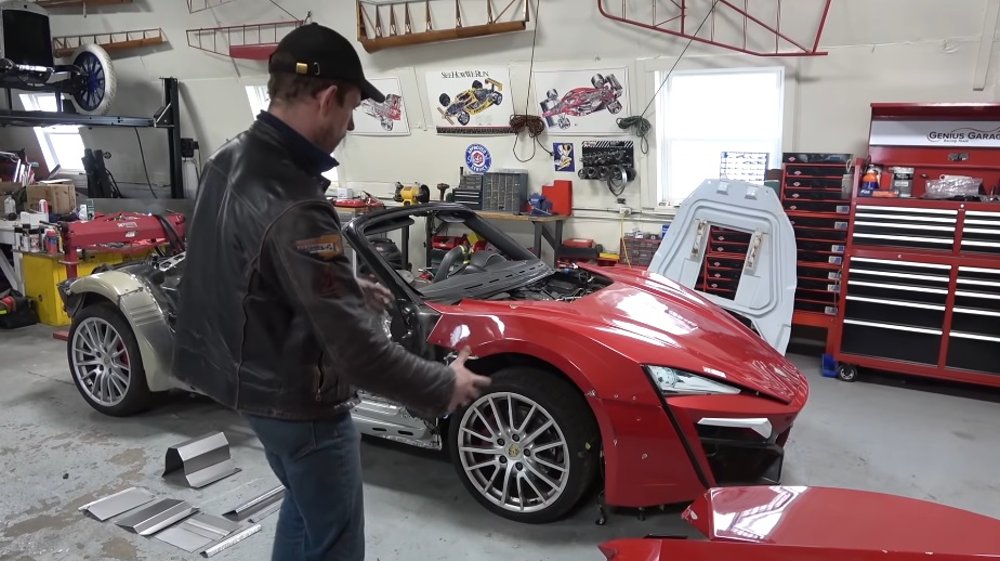Porsche Boxster Being Transformed into a Lykan Hypersport
Porsche Boxster needs to have the chassis stretched eight inches for the Lykan body to fit.
The Lykan Hypersport is one of the world’s most expensive supercars and it is based on Porsche 911 chassis architecture. RUF helped W Motors develop the Hypersport, with the chassis and engine being similar to that of the CTR. Only seven were built and with a price of $3.4-million, only a select few people in the world will ever get to drive one. The car gained popularity with an appearance in Furious 7 and later, the Lykan Hypersport appeared in the British Fast and Furious Live program. However, the car in the live program was not an actual Hypersport. It was a replica built by W Motors and after the show ended, that replica made its way into the hands of Casey Putsch.
Putsch is a well-known racer and recently, he is the head of Genius Garage Racing. This is a program that teaches younger automotive enthusiasts about every aspect of various vehicles and his latest project is using the replica body from Fast and Furious Live to create a running, driving Lykan Hypersport. However, rather than using a RUF CTR or some other derivative of a 911, he is using a 2007 Porsche Boxster.
The Boxster is about eight inches shorter than the Hypersport, so after removing the Porsche body and many items under the body, Putsch had to cut and lengthen the chassis so that the Lykan body will fit. That is where we pick up the project in the video above from Putsch’s YouTube channel.
Fitting the Front End
Before getting into the details of how he stretched the chassis of the Boxster S, Putsch gives us an early look at how the Lykan front end will fit on the Porsche chassis. With all sorts of items removed from the front of the Boxster, the Hypersport front fascia perfectly fits, tucking over the front-mounted cooling system components. Next, he shows how the inner hood piece fits right against the weatherstripping of the frunk, and once that piece is set aside, the shell of the hood is laid on the chassis, completing the front end look of the Lykan.
You will notice that there is a big gap from the hood of the Lykan to the windshield of the Boxster. That entire assembly will have to be removed and a custom A-pillar will need to be constructed. Those issues will be addressed in the future, but in the meantime, we get to see what this Boxster will look like up front with the Hypersport face.
Stretching the Porsche Boxster
When this video begins, Putsch has already cut the Porsche in half, a few inches forward of the rear bulkhead. He needs to add 8.1 inches to the wheelbase and the added length is right under the seats. As it turns out, adding the length is almost the easy part, with the hard part lining up the front end to the rear end. Putsch did so with a floor jack, some boards, scrap metal and popsicle sticks.
The first goal was to get the front and rear chassis sections sitting at the same height relative to the ground, while also keeping both sections level. To do this, the rear section is on a floor jack while the front is sitting on a pile of wood at first. To make small adjustments to the front end, they lift the chassis by hand and insert small metal scraps and popsicle sticks, while the rear end adjustments are made with the jack.
Once Putsch and his assistant have front-to-rear connection leveled up and matching, they clamp the chassis in place and tackle the side-to-side adjustment. They do so by literally kicking the chassis into place. During this effort, Putsch points out that once they add the suspension and get everything dialed-in, an eighth of an inch here or there in the chassis won’t make a difference. At the same time, he wants for it to be perfect, so they want no variance.
Welding it Back Together
The first step of welding the Porsche Boxster chassis back into one piece is to add metal tubing inside of the chassis. These tubes are kind of like jigs, allowing Putsch and his team to form the custom metal chassis parts, but the tubes also hold the chassis in place during the welding. These tubes make sure that the careful measurements aren’t skewed during fabrication and while he plans to remove them at first, he later states that they will be left in for added reinforcement.
When it is time to begin adding the new chassis pieces, Putsch starts with the lower center section which he states is one of the less-important structural bits. Both he and his assistant take turns welding this part into place as the Lykan slowly comes to life.
This chapter of the build ends with Putsch giving us a closer look at the other custom metal chassis pieces that will go into securing the elongated Porsche chassis. Once they are all welded into place, this stretched section of the Boxster will have the same structural layout and the same type of metal, but it will be eight inches longer than original.
After that, Putsch will be able to fit more body parts as the 2007 Boxster S is converted into one of the world’s most expensive supercars.








